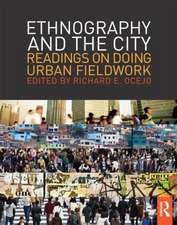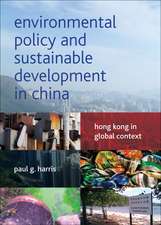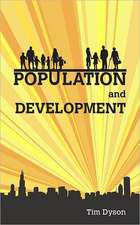Interdependencies Between Fertility and Women's Labour Supply: European Studies of Population, cartea 17
Autor Anna Matysiaken Limba Engleză Paperback – 3 aug 2013
Finally, against the review of theoretical concepts predominantly used for studying interdependencies between fertility and women’s labour supply the book assesses the micro-level empirical studies available on the topic and proposes an analytical approach for modelling the two variables. Thereby, it also contributes to methodological developments in the field.
| Toate formatele și edițiile | Preț | Express |
|---|---|---|
| Paperback (1) | 635.80 lei 6-8 săpt. | |
| SPRINGER NETHERLANDS – 3 aug 2013 | 635.80 lei 6-8 săpt. | |
| Hardback (1) | 642.03 lei 6-8 săpt. | |
| SPRINGER NETHERLANDS – 10 iun 2011 | 642.03 lei 6-8 săpt. |
Din seria European Studies of Population
-
 Preț: 231.11 lei
Preț: 231.11 lei - 15%
 Preț: 644.49 lei
Preț: 644.49 lei - 18%
 Preț: 952.57 lei
Preț: 952.57 lei - 18%
 Preț: 951.47 lei
Preț: 951.47 lei - 18%
 Preț: 953.65 lei
Preț: 953.65 lei - 18%
 Preț: 957.44 lei
Preț: 957.44 lei - 15%
 Preț: 640.88 lei
Preț: 640.88 lei - 24%
 Preț: 799.81 lei
Preț: 799.81 lei - 18%
 Preț: 960.78 lei
Preț: 960.78 lei - 15%
 Preț: 649.06 lei
Preț: 649.06 lei -
 Preț: 395.25 lei
Preț: 395.25 lei - 18%
 Preț: 951.29 lei
Preț: 951.29 lei - 18%
 Preț: 895.27 lei
Preț: 895.27 lei -
 Preț: 393.35 lei
Preț: 393.35 lei - 15%
 Preț: 593.91 lei
Preț: 593.91 lei - 15%
 Preț: 644.49 lei
Preț: 644.49 lei -
 Preț: 415.18 lei
Preț: 415.18 lei - 18%
 Preț: 946.10 lei
Preț: 946.10 lei - 15%
 Preț: 640.88 lei
Preț: 640.88 lei - 18%
 Preț: 951.29 lei
Preț: 951.29 lei - 15%
 Preț: 643.34 lei
Preț: 643.34 lei - 20%
 Preț: 554.98 lei
Preț: 554.98 lei -
 Preț: 383.12 lei
Preț: 383.12 lei -
 Preț: 383.12 lei
Preț: 383.12 lei - 15%
 Preț: 580.79 lei
Preț: 580.79 lei
Preț: 635.80 lei
Preț vechi: 748.00 lei
-15% Nou
Puncte Express: 954
Preț estimativ în valută:
121.66€ • 130.10$ • 101.44£
121.66€ • 130.10$ • 101.44£
Carte tipărită la comandă
Livrare economică 18 aprilie-02 mai
Preluare comenzi: 021 569.72.76
Specificații
ISBN-13: 9789400736467
ISBN-10: 9400736460
Pagini: 200
Ilustrații: XVI, 184 p.
Dimensiuni: 155 x 235 x 11 mm
Greutate: 0.29 kg
Ediția:2011
Editura: SPRINGER NETHERLANDS
Colecția Springer
Seria European Studies of Population
Locul publicării:Dordrecht, Netherlands
ISBN-10: 9400736460
Pagini: 200
Ilustrații: XVI, 184 p.
Dimensiuni: 155 x 235 x 11 mm
Greutate: 0.29 kg
Ediția:2011
Editura: SPRINGER NETHERLANDS
Colecția Springer
Seria European Studies of Population
Locul publicării:Dordrecht, Netherlands
Public țintă
ResearchCuprins
Acknowledgements.- Chapter 1: Introduction.- Chapter 2: Developments in Fertility and Women's Labour Supply in Europe.- Chapter 3: Fertility and Women's Labour Supply: Theoretical Considerations.- Chapter 4: Macro-Context and its Cross-Country Variation.- Chapter 5: Macro-Context and the Cross-Country Variation in the Micro-Level Relationship between Fertility and Women's Employment.- Chapter 6: Women's Employment in Post-Socialist Poland: A Barier or a Pre-Condition to Childbearing.- Chapter 7: Conclusions.- References.- Appendix.- List of Figures.- List of Tables
Recenzii
From the book reviews:
“This book is a major contribution to demographic and comparative social-science research and goes beyond the mere field of fertility and women’s labor supply. … The book is also written in a very lucid style, which makes it easy to follow Matysiak’s theoretical and methodological explanations and arguments. The book is, therefore, very useful and stimulating not only for researchers, but also for students and teachers.” (Gerda Neyer, European Journal of Population, Vol. 30, 2014)
“This book is a major contribution to demographic and comparative social-science research and goes beyond the mere field of fertility and women’s labor supply. … The book is also written in a very lucid style, which makes it easy to follow Matysiak’s theoretical and methodological explanations and arguments. The book is, therefore, very useful and stimulating not only for researchers, but also for students and teachers.” (Gerda Neyer, European Journal of Population, Vol. 30, 2014)
Textul de pe ultima copertă
The book explores interlinkages between women’s employment and fertility at both a macro- and a micro-level in EU member states, Norway and Switzerland. Similarly as many other studies on the topic, it refers to the cross-country variation in the macro-context for explaining cross-country differences in women’s labour supply and fertility levels. However, in contrast to other studies, which mainly focus on Western Europe, it extends the discussion to Central and Eastern European countries. Furthermore, it looks at the macro-context from a multi-dimensional perspective, indicating its four dimensions as relevant for fertility and women’s employment choices: economic (living standards), institutional (family policies), structural (labour market structures), and cultural (social norms). A unique feature of the study is the development of indices that measure the intensity of institutional, structural, and cultural incompatibilities between women’s employment and fertility. These indices are used for ranking European countries from the perspective of the country-specific conditions for work and family reconciliation. A country where these conditions are the worst, but where women are additionally perceived as important income providers, is picked up for an in-depth empirical study of the interrelationship between fertility and women’s employment choices.
Finally, against the review of theoretical concepts predominantly used for studying interdependencies between fertility and women’s labour supply the book assesses the micro-level empirical studies available on the topic and proposes an analytical approach for modelling the two variables. Thereby, it also contributes to methodological developments in the field.
Finally, against the review of theoretical concepts predominantly used for studying interdependencies between fertility and women’s labour supply the book assesses the micro-level empirical studies available on the topic and proposes an analytical approach for modelling the two variables. Thereby, it also contributes to methodological developments in the field.
Caracteristici
Developing measures of potential work-family tensions imposed by the macro-context Ranking EU member states according to the conditions for work and family reconciliation Systematising and assessing the micro-level evidence on women’s employment and fertility Proposing an analytical approach for studying women’s employment and fertility behaviours Extending discussion on women’s employment and fertility to post-socialist countries














